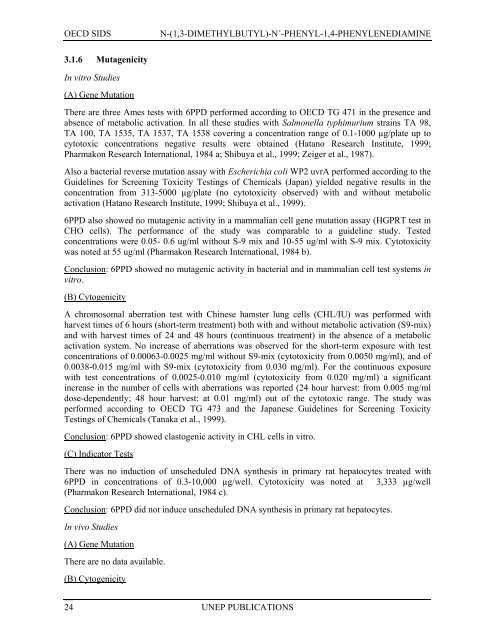N-(1,3-Dimethylbutyl)-N
N-(1,3-Dimethylbutyl)-N
N-(1,3-Dimethylbutyl)-N
Create successful ePaper yourself
Turn your PDF publications into a flip-book with our unique Google optimized e-Paper software.
OECD SIDS<br />
N-(1,3-DIMETHYLBUTYL)-N´-PHENYL-1,4-PHENYLENEDIAMINE<br />
3.1.6 Mutagenicity<br />
In vitro Studies<br />
(A) Gene Mutation<br />
There are three Ames tests with 6PPD performed according to OECD TG 471 in the presence and<br />
absence of metabolic activation. In all these studies with Salmonella typhimurium strains TA 98,<br />
TA 100, TA 1535, TA 1537, TA 1538 covering a concentration range of 0.1-1000 µg/plate up to<br />
cytotoxic concentrations negative results were obtained (Hatano Research Institute, 1999;<br />
Pharmakon Research International, 1984 a; Shibuya et al., 1999; Zeiger et al., 1987).<br />
Also a bacterial reverse mutation assay with Escherichia coli WP2 uvrA performed according to the<br />
Guidelines for Screening Toxicity Testings of Chemicals (Japan) yielded negative results in the<br />
concentration from 313-5000 µg/plate (no cytotoxicity observed) with and without metabolic<br />
activation (Hatano Research Institute, 1999; Shibuya et al., 1999).<br />
6PPD also showed no mutagenic activity in a mammalian cell gene mutation assay (HGPRT test in<br />
CHO cells). The performance of the study was comparable to a guideline study. Tested<br />
concentrations were 0.05- 0.6 ug/ml without S-9 mix and 10-55 ug/ml with S-9 mix. Cytotoxicity<br />
was noted at 55 ug/ml (Pharmakon Research International, 1984 b).<br />
Conclusion: 6PPD showed no mutagenic activity in bacterial and in mammalian cell test systems in<br />
vitro.<br />
(B) Cytogenicity<br />
A chromosomal aberration test with Chinese hamster lung cells (CHL/IU) was performed with<br />
harvest times of 6 hours (short-term treatment) both with and without metabolic activation (S9-mix)<br />
and with harvest times of 24 and 48 hours (continuous treatment) in the absence of a metabolic<br />
activation system. No increase of aberrations was observed for the short-term exposure with test<br />
concentrations of 0.00063-0.0025 mg/ml without S9-mix (cytotoxicity from 0.0050 mg/ml), and of<br />
0.0038-0.015 mg/ml with S9-mix (cytotoxicity from 0.030 mg/ml). For the continuous exposure<br />
with test concentrations of 0.0025-0.010 mg/ml (cytotoxicity from 0.020 mg/ml) a significant<br />
increase in the number of cells with aberrations was reported (24 hour harvest: from 0.005 mg/ml<br />
dose-dependently; 48 hour harvest: at 0.01 mg/ml) out of the cytotoxic range. The study was<br />
performed according to OECD TG 473 and the Japanese Guidelines for Screening Toxicity<br />
Testings of Chemicals (Tanaka et al., 1999).<br />
Conclusion: 6PPD showed clastogenic activity in CHL cells in vitro.<br />
(C) Indicator Tests<br />
There was no induction of unscheduled DNA synthesis in primary rat hepatocytes treated with<br />
6PPD in concentrations of 0.3-10,000 µg/well. Cytotoxicity was noted at 3,333 µg/well<br />
(Pharmakon Research International, 1984 c).<br />
Conclusion: 6PPD did not induce unscheduled DNA synthesis in primary rat hepatocytes.<br />
In vivo Studies<br />
(A) Gene Mutation<br />
There are no data available.<br />
(B) Cytogenicity<br />
24<br />
UNEP PUBLICATIONS
















